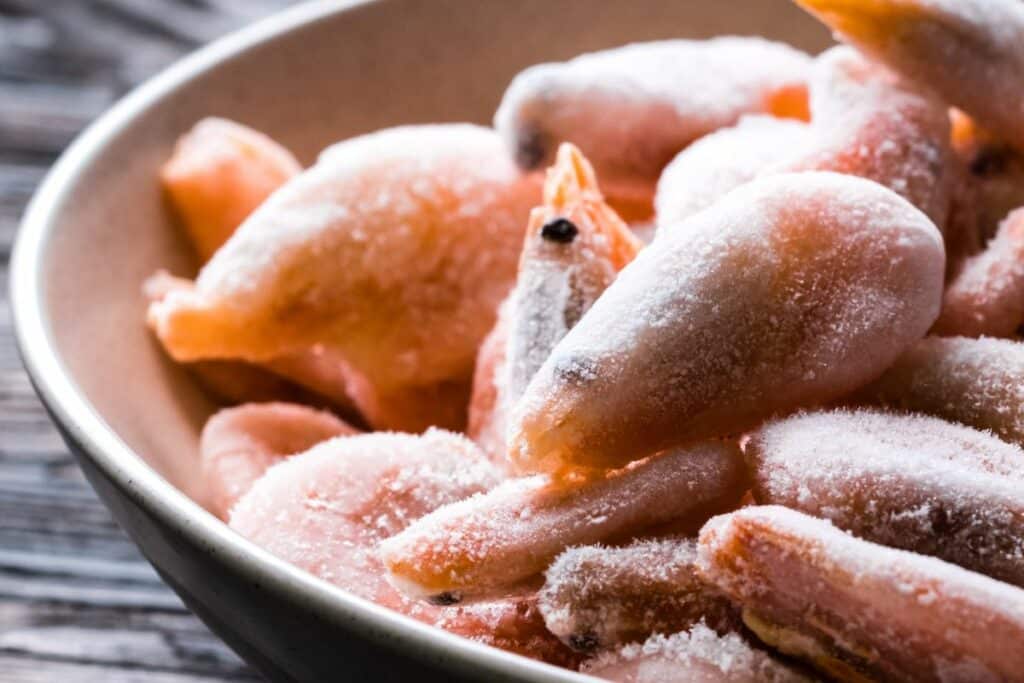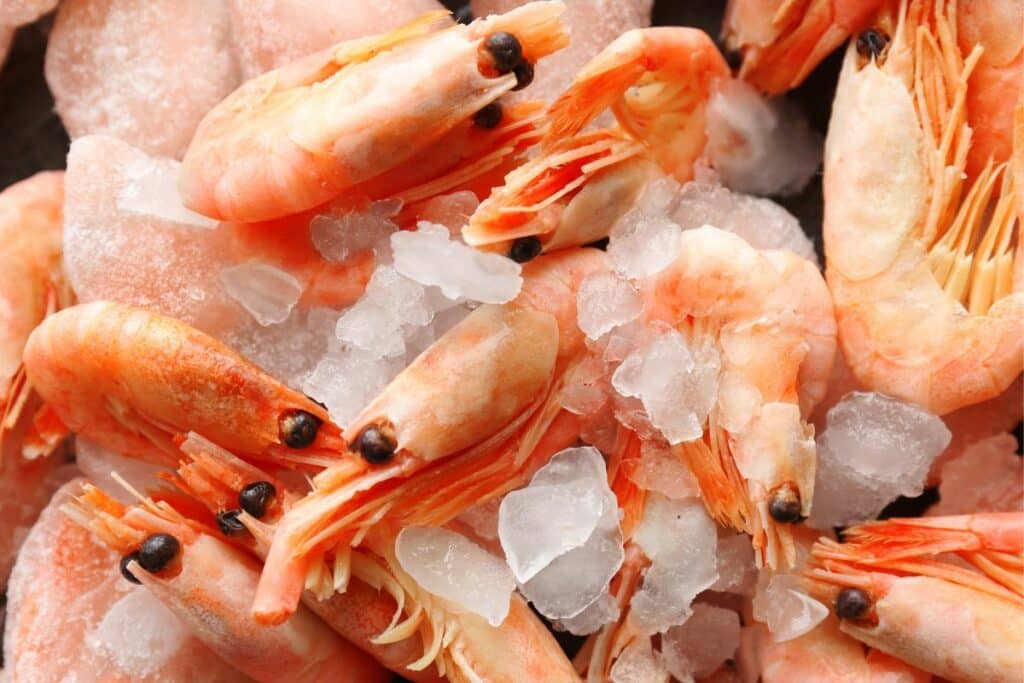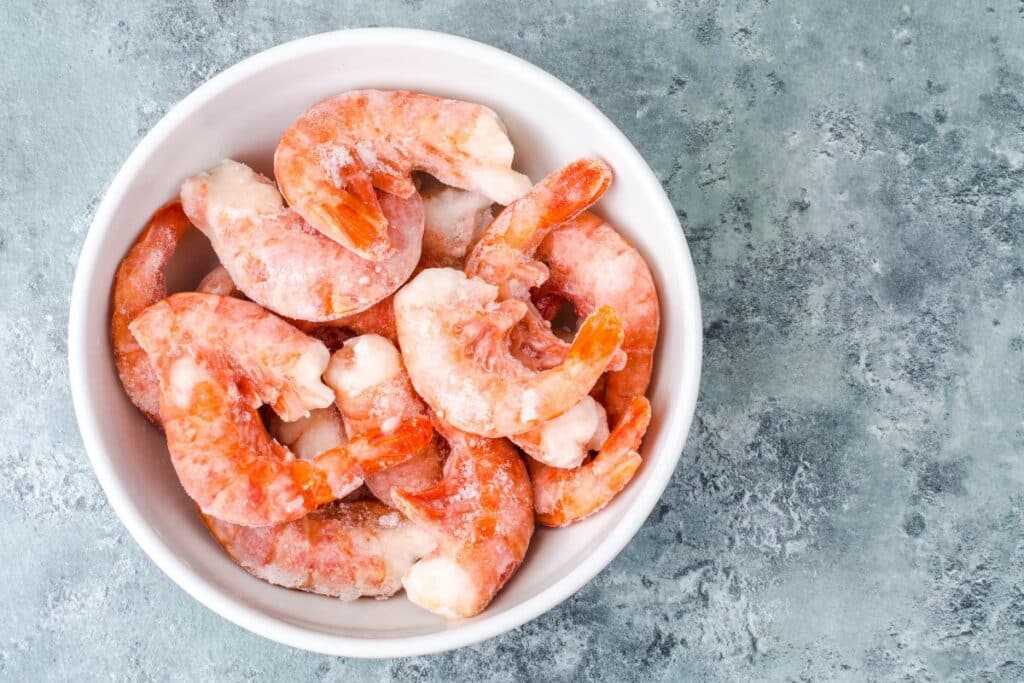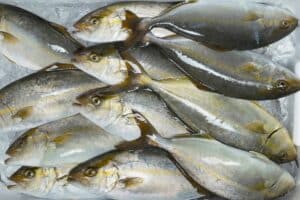Freezer burn is a problem that many people face when storing food in the freezer for an extended period.
It occurs when frozen food is exposed to air, causing moisture loss and resulting in the formation of ice crystals on the surface of the food.
This process can have a significant impact on the quality of the food, affecting both its texture and flavor.

Freezer burn is an issue regarding shrimp, which can lead to food safety concerns.
Here, I’ll share information on how to identify freezer-burnt shrimp, whether you can still eat the shrimp, as well as some other helpful tips.
Is It Safe To Eat Freezer Burnt Shrimp?
Yes, freezer-burnt shrimp can still be eaten and used in various recipes, but it may have a tough texture and an unpleasant freezer-burn taste.
However, it’s important to note that extended periods of freezer burn can cause shrimp to become unsafe to eat.
If you’re unsure if a freezer-burnt shrimp is still okay to consume, it’s best to err on the side of caution and discard it to avoid food poisoning.
Personally, I tend to avoid eating shrimp with freezer burn as I just don’t think it’s worth the risk.

Can You Revive Frozen Shrimp That Has Freezer Burn?
While you can’t completely reverse freezer burn on shrimp, you can still use them in cooking.
Freezer burn leads to dehydration and affects taste and texture, but the shrimp usually remain safe to eat.
To improve their quality, you might consider using them in dishes with strong flavors or sauces, like curries or stews, where the impact of freezer burn is less noticeable.
However, if the quality is significantly compromised, it might be best to discard them.
What Are The Signs Of Freezer Burn In Shrimp?
To check for freezer burn in shrimp, inspect the surface for the presence of ice crystals or a layer of ice.
Next, look for the following signs to check the quality of the shrimp:
- Dry, Slimy Texture: If the shrimp feels dry or slimy to the touch, it is a sign of freezer burn. Freezer burn can cause moisture loss, resulting in a rubbery or tough texture.
- Uneven Coloring: Freezer burn can cause the shrimp to have an uneven coloring. Some parts may look darker or lighter than others.
- Opaque Color: The shrimp may appear opaque if it is freezer-burned. This means that the shrimp has lost its translucency and no longer appears fresh.
- White Spots or Discoloration: White spots or discoloration on the surface of the shrimp is another sign of freezer burn.
- Salty or Strong Ammonia Smell: If the shrimp smells salty or has a strong ammonia smell, it could be freezer-burned.
If you notice any of these signs, you may want to discard the shrimp to avoid consuming any potentially unsafe food.
As I said above, it is usually safe to consume freezer-burnt shrimp, but the quality will be diminished, and it’s often best to be cautious.
How Does Freezer Burn Occur?
Freezer burn is a common food safety issue that occurs when food is stored improperly in the freezer.
Essentially, freezer burn takes place when the frozen product is exposed to air.
The moisture from the surface of the food evaporates due to sublimation, which leaves the food dehydrated, damaged, and discolored.
Freezer burn can happen to various types of food, including meat, vegetables, and seafood, like shrimp.
Food storage is a crucial factor in the occurrence of freezer burn. When food is not sealed or packaged properly, it can be exposed to air, leading to moisture loss and freezer burn.
The most common storage mistakes that lead to freezer burn are using the wrong packaging materials or containers, failing to remove as much air as possible from the container, and storing food for extended periods in the freezer.
Other factors that can contribute to the development of freezer burn include temperature fluctuations in the freezer and the freezer door being opened frequently.
In shrimp, freezer burn can affect its texture and appearance.
The ice crystals that form on the surface of the shrimp can cause it to become dry, rubbery, or tough, affecting its texture when cooked.
It can also cause changes in the color of the shrimp, making some parts darker or lighter than others.
How To Store Shrimp Properly In The Freezer

I’ve talked a lot about the issues associated with freezer burn, but that doesn’t mean you can’t freeze your shrimp – you just need to know how to do it properly.
The first step to properly store shrimp in the freezer is to ensure they are clean and dry before freezing.
To clean and devein the shrimp, rinse them under cold running water and remove the shells and tails.
To remove the vein from a shrimp, make a shallow cut along its back. Rinse the shrimp and pat dry with paper towels.
Once sufficiently dry, place the shrimp in a single layer on a parchment paper-lined baking sheet.
Put the baking sheet in the freezer for an hour or two until the shrimp are completely frozen.
After the shrimp are frozen solid, transfer them to a freezer-safe container or bag. To avoid freezer burn, ensure you don’t trap any air in the container or bag.
To do this, use a vacuum sealer or simply press down on the bag with your hands to squeeze out the air.
Label the bag with the date and contents, and store it in the freezer for up to three months.
Buy High-Quality Shrimp To Help Avoid Freezer Burn
I would also recommend buying high-quality shrimp, as this will help reduce the risk of freezer burn.
The best place to buy high-quality shrimp is from a local seafood market or fishmonger. They will have access to the freshest, best-quality shrimp.
Additionally, you can purchase fresh, frozen shrimp online from reputable suppliers, such as Vital Choice or Sea to Table.
Conclusion
It is often safe to eat freezer-burnt shrimp but bear in mind that the taste and texture may be affected.
If you have any concerns at all about the safety of the shrimp, I would recommend discarding it instead. It’s not worth the risk if it may cause an issue.
If you consume freezer-burnt shrimp, take extra precautions to ensure that it is cooked properly and that all the bacteria have been killed.
FAQs
Yellowing on frozen shrimp can indicate the use of preservatives like sodium bisulfite, or it may suggest spoilage. If you’re unsure about the shrimp’s quality, it’s safer not to consume it.
The blackening of shrimp in the freezer usually results from oxidation or spoilage, often due to improper sealing or temperature fluctuations. If you notice this change, it’s safer to discard the shrimp.






